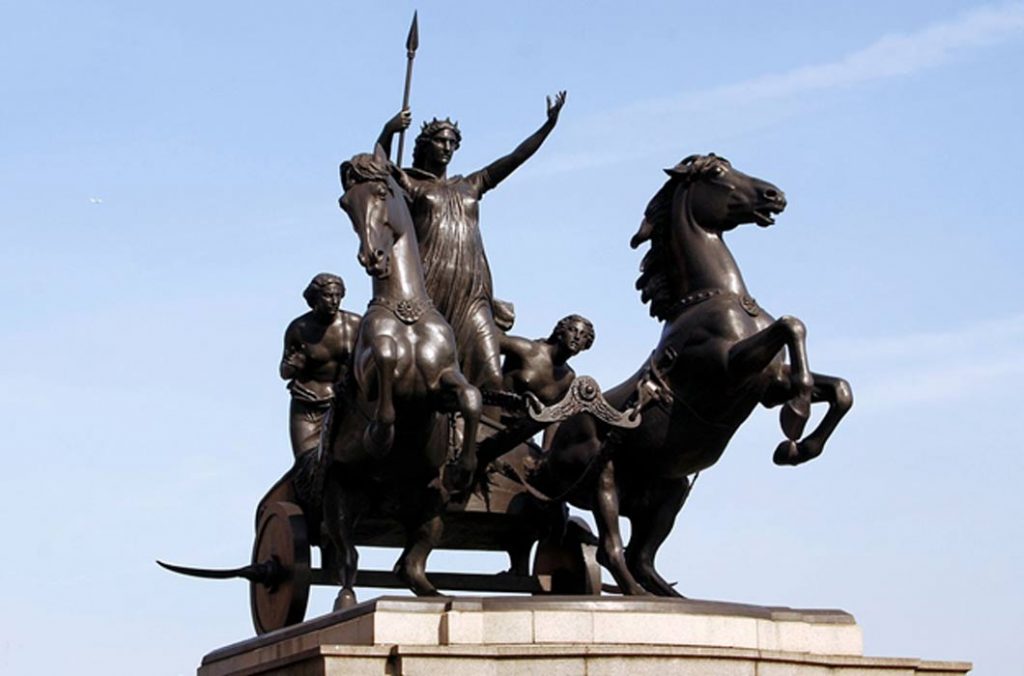She raised a rebellion against Rome. Her wrath burned London to the ground.
When Rome began its conquest of England in 43 CE, the Iceni tribe were already well established in what is now modern-day East Anglia, Britain. The Iceni King, Prasutagus, became an ally of Rome after an unsuccessful rebellion in 47 CE.
He divided his estate between his two daughters and Nero of Rome. Prasutagus believed this would make sure his children were taken care of. Prasutagus left his wife, Queen Boudicca, without an inheritance, presumably because she was hostile toward Rome. Prasutagus hoped this gesture would show Rome his children would continue the same amicable policies he held.
Upon his death in 60 CE, however, Rome took all of Prasutagus’ lands and the Iceni were no longer considered allies. His lands were pillaged by Roman centurions. His household was plundered by his slaves. Iceni chiefs also had their estates taken by the Romans.
Boudicca objected to the actions of Rome. She was flogged and her daughters raped.
Boudicca was enraged. With her people, she led a revolt against Rome in 60/61 CE and destroyed everything in her wake.
Details of her revolt come to us from Roman historians, Publius Cornelius Tacitus (56-117 CE) and Cassius Dio (150-235 CE), however, Tacitus’ version over Dio’s is accepted as the more factual account. This is chiefly because the governor in Britain responsible for successful conquests of Britain was Gnaeus Julius Agricola, Tactitus’ father-in-law and source of his information.
Tacitus recorded in his Annals what Boudicca said to get the support of the people to fight against Rome.
We British are used to women commanders in war; I am descended from mighty men! But I am not fighting for my kingdom and wealth now. I am fighting as an ordinary person for my lost freedom, my bruised body, and my outraged daughters…. Consider how many of you are fighting — and why! Then you will win this battle, or perish. That is what I, a woman, plan to do!— let the men live in slavery if they will.
Boudicca saw that Roman Governor Gaius Suetonius Paulinus was fighting the Britons on the island of Mona (Anglesey). The island was a refuge for British rebels. The druids also lived there. Boudicca and the Iceni, with their Trinovantes neighbors and others, plotted a revolt. They chose Boudicca to lead them.
Tacitus recorded in his Annals what she told her new army.
It is not as a woman descended from noble ancestry, but as one of the people that I am avenging lost freedom, my scourged body, the outraged chastity of my daughters. This is a woman’s resolve; as for men, they may live and be slaves.
Boudicca first attacked the Roman city Camulodunum (Colchester), former Trinovantian capital, before moving on to Londinium (London) and Verulamium (St. Albans). They were left in ruins.
Roman Governor Gaius Suetonius Paulinus had traveled with his army to Londinium, but, upon learning Boudicca’s army was bigger, left before she arrived. He offered safe passage out of the city to any who accepted.
As a result, 70,000-80,000 lay dead in Boudicca’s wake. Anyone who didn’t flee was tortured and murdered.
Boudicca’s army of 80,000-250,000 men met Suetonius and his army of about 10,000 men at the Battle of Watling Street. Watling Street was an ancient trackway used by the Britons. It connects modern Canterbury and St. Albans. The Romans paved the route and connected it to several Kentish ports and a bridge over the River Thames in Londinium. It went through Verulamium and Viroconium (Wroxeter).
Though Suetonius’ army was outnumbered, they were well-disciplined. Boudicca’s army was poorly equipped.
Suetonius had chosen the area because of the tactical advantage to him of being protected on three sides.
Both leaders are said to have encouraged and inspired their troops and then Suetonius gave the signal for battle and the infantry moved forward to throw their javelins. Boudicca’s superior numbers were of no advantage in the narrow field Suetonius had chosen and, in fact, worked against her as the mass of men pushed together provided easy marks for the Romans.
The Britons fell back before the javelin assault and then the advancing wedge formation which cut through their ranks. Suetonius ordered in his auxiliary infantry and then his cavalry and the Britons turned to flee the field. The supply train they had arranged at their rear prevented their escape and the rout turned into a massacre.
Although Boudicca fled and survived, she died soon after.
Boudicca’s death has never truly been determined. Tacitus reported she committed suicide to avoid being captured while Dio reported she died of illness.
Queen Victoria would later consider Boudicca her namesake since their names had the same meaning. Alfred, Lord Tennyson wrote a poem, “Boadicea,” about her and ships bore her name. A statue was made of her in her war chariot with horses. The horses that were used as models belonged to Prince Albert, who loaned his equines to artist Thomas Thornycroft. The statue rests on a plinth on the Victoria Embankment next Westminster Bridge and the Houses of Parliament in London.
Boudicca has been so revered in the United Kingdom that the Welsh chose her as one of eleven statues of historical figures that should be included in the Marble Hall at Cardiff City Hall in 2016.
In Cardiff, Boudicca is depicted more as a motherly figure than woman warrior. She is the “most ancient, the only female, and only antecedent from outside the modern Welsh nation.”
The Iceni queen from a Celtic clan led her people in war, succeeding in three large battles. Her story was nearly lost to history, but Tacitus recorded what he could of the warrior woman who fought for justice for her daughters, for herself, and for her people.


Leave a Reply